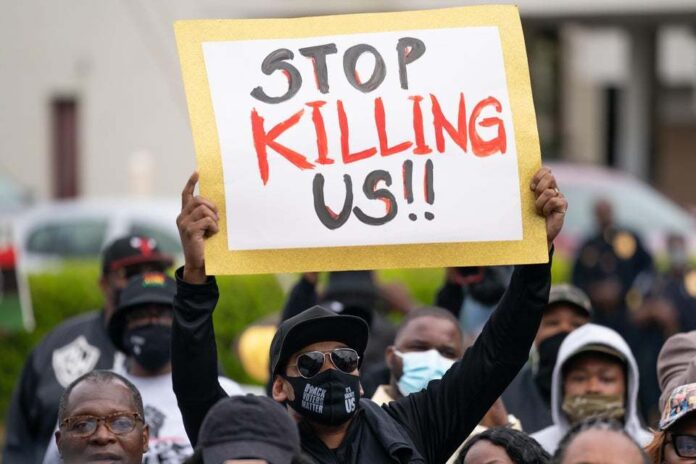According to statistics from the online database "Mapping Police Violence", at least 1,124 civilians will be killed by police brutality in the United States in 2021. Of those, 888 died at police gunfire, The Washington Post estimates.
The database showed police in the U.S. killed "almost every day" all but 15 days last year, and most of the incidents occurred when civilians committed nonviolent crimes or no crime at all.
Some scholars believe that the root of this phenomenon lies in gun violence in American society, and the danger of police work has led to "combat-oriented" police culture. At the same time, the locality of police in the United States makes it difficult for under-resourced areas to complete police training and supervision.
Victims of police violence top 1,000 for 9 years in a row
According to foreign media reports on the 10th, the non-profit organization "Mapping Police Violence" has continued to track violent law enforcement incidents by American police in recent years. The organization said that at least 1,124 people were killed by police in 2021, and there were only 15 days in the year without similar incidents. victims. However, in the group's view, last year's death toll was "not new."
Since 2013, the number of U.S. deaths due to police brutality has remained above 1,000 each year, the group said. The data shows that most police killings (about 66 percent) occurred during traffic stops, mental health checks, civil unrest, and when civilian victims were charged with nonviolent crimes or no crime at all. In 2021, as many as 122 people will die in police brutality during traffic stop checks.
The Washington Post estimates that 888 civilians will die at the gunpoint of American police in 2021. Data from the last five years shows that fatal shootings involving police officers have remained relatively stable in terms of number, incident situation, and overall victim demographics. The victims were young men, mainly between the ages of 20 and 40. Second, African-Americans and Hispanics in the United States are much more likely to be shot by police than whites. Even though blacks make up less than 13 percent of the country's population, they are more than twice as likely to be shot by police as whites.
In addition, police shootings of civilians occurred in every state across the United States and occurred more frequently in cities with high population concentrations. In some cities, including Los Angeles, police killings of civilians more than doubled in 2021 compared to 2020, said Samuel Sinyangwe, co-founder of the Mapping Police Violence database.
It is also reported that there have been no police shootings in New Jersey throughout 2020, and on the first day of 2021, a 39-year-old African-American man was shot by police detectives.
Gun violence in the U.S. spawns a 'combat-oriented' police culture
The report also said that 2014 data showed that the shooting incidents of American police officers were 18 times that of Danish police officers and 100 times that of Finnish police officers. In addition, police in the United States kill civilians significantly more frequently than police in France, Sweden and other European countries. Paul Hursfield, an associate professor of sociology and criminal justice at Rutgers University, pointed out that a big reason for this phenomenon is the gun culture in the United States.
"More guns mean more aggressiveness." Unlike European countries, most U.S. states allow adults to buy self-defense pistols, which they can carry with them almost at any time, Hursfield said. And it's not difficult to obtain guns illegally in the United States. About 57 percent of civilians who died in police shootings in 2015 were reportedly charged with possessing a real, toy or replica gun.
As a result, the shadow of gun violence makes the country's police often ready to shoot in advance, amplifying the threat of items held by civilians, and even mistaking mobile phones and screwdrivers for guns. The proliferation of guns has not only made policing in the United States more dangerous, but it has also fostered a "combat-oriented" police culture that emphasizes "courage and aggression." As a result, even unarmed Americans are more likely to be killed by police with low-lethal weapons such as knives.
Another key factor, Hursfield noted, is the "localist" nature of American police. According to statistics, more than a quarter of the victims of fatal police enforcement incidents are in towns with a population of fewer than 25,000 people, which is much higher than the proportion of these towns in the United States.
According to him, generally, applicants for police positions are subject to strict screening, discipline and weapons training after taking office. However, some areas with insufficient resources may not be able to complete the training review well. To make matters worse, cash-strapped local governments may use tickets, fines, seizure fees and asset forfeitures as a source of revenue for police and push more police officers to engage in such bad behavior.
In addition, there are differences in the standards for police use of lethal weapons in the United States and European countries. In Europe, police tend to refrain from shooting if other options exist, as in Spain, where police are required to gradually issue verbal warnings, fire warning shots, and shoot non-critical parts of the body before using lethal force. But in the U.S., only eight states require police officers to give verbal warnings when possible, and there are no rules for firing warning shots or shooting in the legs.
Xin Yangwei said: "Despite calls for change, the data shows that the police have not reduced the killing of civilians." At the same time, the "Washington Post" pointed out that without major social changes, such as a fundamental shift in police culture or a change in gun control With extreme limits, the number of civilians American police shoot and kill each year will "stay the same."







































